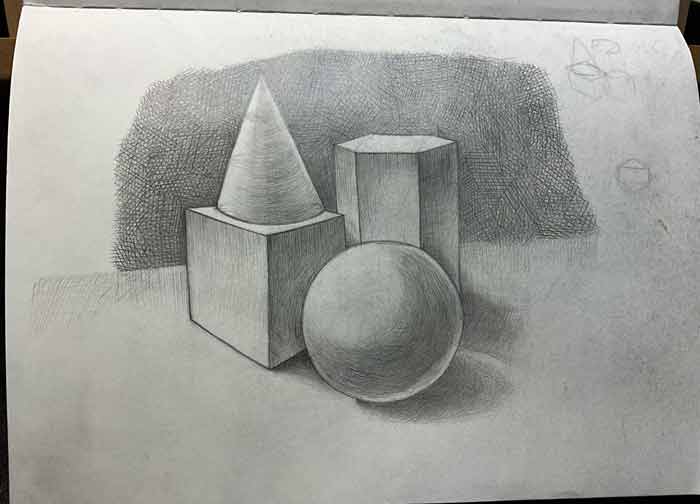Artwork and questions from Klent, Drawing Academy student
I recently have attempted rendering shades of this still life. Am I overworking my paper with how hard I’m pressing? I feel like I didn’t adequately keep my pencil sharp throughout the first half of the drawing so I’m getting a lot of smudging. Also I’m not quite sure how to work out the edges of each shape without intruding in on the shape or making the outline look shaky; which caused me to purposely outline each shape to differentiate the background and object.

Feedback from Vladimir London, Drawing Academy tutor
Dear Klent,
Thank you for your drawing, comments and questions.
To begin with, you do not have to copy drawings from the video lessons. Making copies of flat images has very little educational value. Actually, the more you copy, the harder it will be for you to draw from life. This is because copying requires a very different set of skills than drawing. Here are two videos for you to learn more:
Why drawing photos is treacherous
Drawing from photos
Instead of copying what you see in the Drawing Academy videos, you need to learn the drawing principles and techniques explained and those lessons and use them when drawing your own pictures from life and imagination. How to study in the Drawing Academy course and benefit from its video lessons is explained here:
How to study drawing the right way
Can you learn to draw by copying
Now about your drawing. It is very good that you invest enough time and attention into rendering tonal values, but there are many things to improve even before you attempt rendering.
First, you need to draw on a bigger scale. Go for A2 or similar big size of good quality drawing paper if you plan on making a fully rendered artwork. Going small is much easier than re-learning drawing and rendering big images.
Secondly, you need to plan your composition. For example, this still life drawing is not big enough for the paper sheet and it is shifted to the left-hand side, leaving a big empty space on the right.
When it comes to constructive drawing, there is so much to learn and improve. For example, the cube in your artwork is distorted. It is also in a different perspective to the hexagonal prism. You do not spot such mistakes simply because the “sense of perspective” is not developed enough. This ability only comes with practice of drawing geometric solids from life. There is also another way of checking distortions; it is described here –
How to Spot Mistakes in Perspective Drawing
Here’s the thing – if you have troubles with drawing the simplest three-dimensional cube in perspective, it would be very unlikely to avoid mistakes when drawing any other more elaborate objects, portraits for example. Tonal rendering won’t fix such constructive mistakes, so you would end up with distorted objects with added tonal values. After you render values, fixing such mistakes becomes more difficult.
Talking of tonal rendering, there is so much to learn and improve once again. You need to learn how to render the entire sheet rather than its central area; how to use the aerial perspective, which is totally absent in your drawing; how to use the best directions of contours to describe the three-dimensional nature of objects; how to use a better gamut of pencil strokes; how to combine shading and hatching in one piece; how to avoid monotone hatching, which looks boring and mechanical; and so on.
You asked about edges of objects, cutting them out with bold lines doesn’t give good results. There are no lines in real life, but borders between planes with different tonal values.
One email would be too small for explaining everything you need to know. That is why we created several drawing courses. However, watching video lessons and doing some exercises is not enough. The biggest challenge you have is lack of professional one-to-one tutoring. The history of arts doesn’t know a single great fine artist who was completely self-taught. Every master had a talented teacher. There is a reason for that. If you cannot see your mistakes and repeat them again and again; the more you practice, the better you will become at making such mistakes. This way, a lifetime won’t be enough to learn really good drawing techniques.
If you are serious about getting strong drawing skills, the fastest and easiest way is to take private lessons from professional artists and art teachers on a one-to-one basis. There is one drawing course available today on the Internet where you will get unlimited lifetime personal tutoring for a very low one-time fee – Life Drawing Academy Correspondence Course. In this course, we guarantee that you will achieve the advanced level of drawing skills should you complete all 100 drawing tasks one by one as instructed under guidance of tutors.
To find out which level of drawing skills you have, you can check out this video – How to self assess your drawing skills
Kind regards,
Vladimir London





Wow! What a feedback! By reading this article I’ve learned about drawing more than during 4 years at my art college. My art teachers never told me how to study drawing, how to avoid mistakes, or anything about constructive drawing. I also enjoyed the “Self assess your level” video!
Thank you